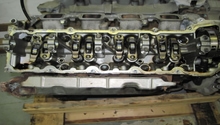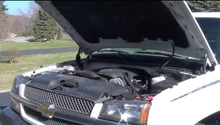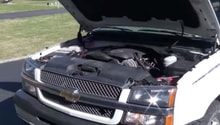Chevrolet Silverado 2007-2013: Performance Diagnostic Guide
An engine can get sick, much like us. The shakes (engine vibrations), a fever (overheating), or excessive consumption (put down the doughnut!). Fortunately, the car is usually more easily mended than the person, so let's get to the root of the cause!
This article applies to the Chevrolet Silverado GMT900 (2007-2013).
This article will cover some of the most common issues found in the 2007 to 2013 Silverados, including high oil consumption, vibrations, engine overheating, smoke on startup, and hard starts. If your truck is still under warranty, it would be best to take it to the dealership first before beginning any work yourself because you could end up voiding the warranty.

Materials Needed
- Full socket set
- Multimeter
Issue 1 – High oil consumption
A engine valve stem may have a nick in it.
This item plagues majority of the 5.3L motors with active fuel management (AFM). The root cause of the issue is still being debated, but most forum members contribute it to when the engine switches into 4-cylinder mode, it allows oil to get by and burn off. However, Chevrolet has issued a Technical Service Bulletin (07-06-01-007F).
To repair a faulty valve stem:
- Remove the valve stems.
- Inspect each one at all angles for any nicks or gouges.
- If any are found, both heads will need to be replaced.

Issue 2 – Truck vibrates while driving
The tires may not be properly balanced.
This issue is mainly only found in the 2011 to 2013 model year trucks, and unfortunately, no real cause is known for it. This one seems to be a mystery as to the root cause. People have thrown various solutions at their trucks with mixed results. It's a 50/50 chance anything you or the dealership tries to fix will actually solve the problem.
Some of the more common solutions have been:
- New road-force balanced tires: It is suggested going to a reputable tire shop to have this done, as the dealerships have been known to balance the tires improperly.
- New steering column: While not as common, some owners have noticed excessive play in the steering linkage and replacing it has fixed the issue.
- Adding a Tonneau cover: Some owners have noticed the problem goes away after adding a cover to the bed of the truck.
It should be noted that on other vehicles, this sensation is often attributed to worn control arm bushings in the front end, or other overly-soft as well as worn suspension components. Food for thought.

Issue 3 – Engine overheat warning
The ECT sensor might have gone bad.
The ECT (Engine Coolant Temperature) sensor sends a signal to the ECM based on the temperature it reads. The higher the temperature is, the lower the voltage it sends. This signal controls when your truck starts pumping coolant through the radiator as well as when the radiator fans turn on to cool the coolant down. These sensors don't last forever and depending on the batch, they can be prone to getting stuck in a position where it's sending the wrong signal. The first thing you'll want to do is replace the sensor as they are relatively inexpensive (around $20 to $30). If with a new sensor the problem still occurs, you'll want to use a multimeter and trace the wires from the ECT to the ECM, looking for any shorts.

Issue 4 – Blue smoke on startup
The PCV valve may have gone bad.
Normally, blue smoke on startup is a sign that valve seals have gone bad. However, another common cause is the PCV valve has gone bad. Since the PCV valve is both cheap and easy to replace, it is suggested doing that first.
If replacing the PCV valve doesn't fix the issue, you'll need to:
- Replace the valve seals.
- Inspect valve guides for wear, and replace if necessary.

Issue 5 – Motor is hard to start
The check valve in the fuel pump may have gone bad.
The check valve on the fuel pump allows fuel to drain out of the lines when the truck is turned off and back into the fuel tank. If the check valve goes bad, it may allow the fuel to always be trying to drain out of the lines regardless if the truck is on or off. To test for this, you can try priming the fuel system. If it starts normally after priming, then the check valve has gone bad and the fuel pump will need to be replaced. To prime the system, you'll need to cycle the key to get the motor to turn over for about two seconds, go back to off, and repeat three to four times.

Related Discussions
- 5.3L Consuming Oil - ChevroletForum.com
- Vibration At Idle - ChevroletForum.com
- Overheating, Turn Off Engine Light - ChevroletForum.com
- Smoke on Startup - ChevroletForum.com
- Silverado Hard Starting - ChevroletForum.com






